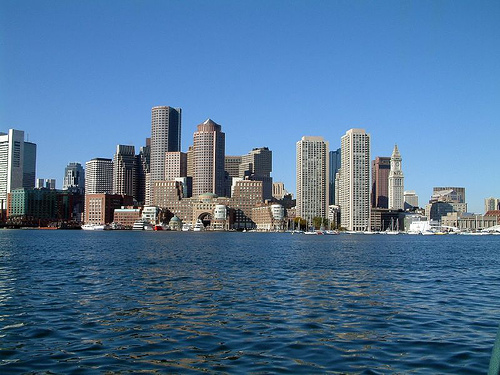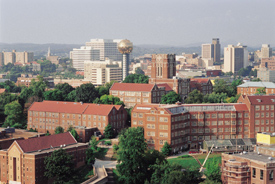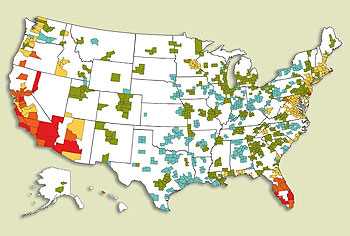140: US Real Estate Investment – the fundamentals and trends
06-24-2007
PropertyInvesting.net Team
Lots of scare stories about the state of the US economy again. We’ve been getting these for the past 30 years. Every time the doubting Thomas’s have been proved wrong. The so called meltdown has so far not appeared.  GDP growth is clipping along at 3% and employment is strong. Okay, in some places real estate prices have dropped, may be 5-10% and other areas have hit a period of doldrums. But this is not a crash or recession or depression. It does not look like it will be either. Even if the economy slowed, interest rates would drop to compensate. Inflation is relatively high, but excess capacity should see this dropping back in the next year.
GDP growth is clipping along at 3% and employment is strong. Okay, in some places real estate prices have dropped, may be 5-10% and other areas have hit a period of doldrums. But this is not a crash or recession or depression. It does not look like it will be either. Even if the economy slowed, interest rates would drop to compensate. Inflation is relatively high, but excess capacity should see this dropping back in the next year.
There are a few basic fundamentals about the US economy that stand it in very good stead in a global world economy:
· Population: Rapidly growing population – this was 150 million in 1950, is now 300 million and will be 450 million by 2050.
· Land: huge tracts of land, many areas under-populated and room to expand in most states
· Resources: water, excellent agricultural land, different climates, plentiful water in most areas, enough oil and gas for half the countries needs, enough coal to last for 100s of years, mineral wealth
· Education: a highly educated population – motivated workers, mainly non-unionize and free market economy, technology is the envy of the world with much innovation
 The financial service have lost their gloss somewhat – probably due to Middle East money heading to Europe, Sabine Oxley regulations and the growth of London, but New York is still the largest financial centre in the world and is growing at a healthy level.
The financial service have lost their gloss somewhat – probably due to Middle East money heading to Europe, Sabine Oxley regulations and the growth of London, but New York is still the largest financial centre in the world and is growing at a healthy level.
The fact the population is expanding is positive news in that a large proportion of the population are of working productive age, and this benefits the economy. Large numbers of immigrants provide low priced labor to further develop the economy and keep wages inflation under control. Mortgage borrowing compared to earnings is still quite moderate in most areas – particularly the mid west.
So – where are the best places to invest in real estate?
Babyboomers Retire: Wealthy professional and business people will drive the real estate market – and where they will be retiring in next 10-30 years. This includes the retirin g babyboomers – wealthy people from the west coast and NE USA that will settle in sunny coastal areas. So property along the Atlantic seaboard from Maryland to Florida will likely rise at above country trend levels. Coastal areas around Bston and New York will also prosper. Coastal North and South Carolina will likely rise even faster than neighboring areas because of the nice climate, expanding population, new businesses moving in and popular retirement towns springing up. The same is true of the area from Miami and Florida Keys through to the western Florida panhandle. Ditto all coastal areas of California. Baja is another desert area that will boom – with strong links with Mexico and energy business expansion. Other popular retirement area will be Arizona (Phoenix) because of all year round sun and dry – but with plenty of golf courses. Bolder and Aspin in Colorado are other popular areas for retirees. Las Vegas will continue to boom as a holiday destination for retried babyboomers – Colorado Springs is an other potential hotspot.
g babyboomers – wealthy people from the west coast and NE USA that will settle in sunny coastal areas. So property along the Atlantic seaboard from Maryland to Florida will likely rise at above country trend levels. Coastal areas around Bston and New York will also prosper. Coastal North and South Carolina will likely rise even faster than neighboring areas because of the nice climate, expanding population, new businesses moving in and popular retirement towns springing up. The same is true of the area from Miami and Florida Keys through to the western Florida panhandle. Ditto all coastal areas of California. Baja is another desert area that will boom – with strong links with Mexico and energy business expansion. Other popular retirement area will be Arizona (Phoenix) because of all year round sun and dry – but with plenty of golf courses. Bolder and Aspin in Colorado are other popular areas for retirees. Las Vegas will continue to boom as a holiday destination for retried babyboomers – Colorado Springs is an other potential hotspot.
Coal: The once depressed coal mining areas around the Green River of Wyoming are being rejuvenated by the current coal mining boom. Hundreds of years of high grade anthracite coal is the mainstay of the US power industry in the east. With depleting oil and gas reserves, this coal will become ever more important and this boom is likely to stay, despite environmental concerns on CO2 emissions. In the northern parts of Colorado there may also be an oil shale boom, just south-west of the Green River area. So rentals for mine workers could be good business.
Oil & Gas: Houston is the biggest oil city in the world. Despite the USA’s depleting oil and gas, many of the largest global oil and gas companies have either their headquarters or large offices in Houston. Because of globalization, this has become a major engineering center of excellence for the global oil and gas businesses.  Along the creek to Galveston is the biggest oil refining concentration in the USA – thousands of refining and chemicals jobs, plus large port – the refineries will not disappear because of refining shortages in the country and no immanent end to the fuel combustion engine. Houston went through a massive downturn in 1986 ($8/bbl oil) and again it was hit in 1999 ($10/bbl oil), but with oil prices likely to stay in the $50-$60/bbl plus and refinery margins now very healthy, Houston (as well as Dallas and Galveston) will benefit hugely and this will positively affect real estate prices. The region had one of the lowest real estate prices inflation from 1986 onwards for 20 years – now they will be set above country trend as they catch up. Greater environmental constraints in land use around Houston will also drive up prices. As crime reduces and unemployment levels drops, some inner city areas close to downtown Houston may see price drive very high very quickly.
Along the creek to Galveston is the biggest oil refining concentration in the USA – thousands of refining and chemicals jobs, plus large port – the refineries will not disappear because of refining shortages in the country and no immanent end to the fuel combustion engine. Houston went through a massive downturn in 1986 ($8/bbl oil) and again it was hit in 1999 ($10/bbl oil), but with oil prices likely to stay in the $50-$60/bbl plus and refinery margins now very healthy, Houston (as well as Dallas and Galveston) will benefit hugely and this will positively affect real estate prices. The region had one of the lowest real estate prices inflation from 1986 onwards for 20 years – now they will be set above country trend as they catch up. Greater environmental constraints in land use around Houston will also drive up prices. As crime reduces and unemployment levels drops, some inner city areas close to downtown Houston may see price drive very high very quickly.
Finance: Financial services in developed economies tend to take a larger and larger proportion of the economy and wealth through time – they expand as manufacturing is generally stagnant (much manufacturing being transferred to developing countries like China, Brazil and India). This trend is not likely to change – New York is and has always been the main financial centre in the USA. It’s pre-eminence globally is being challenged by London, but despite this, New York is still growing at a healthy rate. So expect this to continue to spill over into the real estate market. The most select places in New York will likely see further rises and regenerating areas like the Bronx will also rise as more professional finance people move in. Other major cities with large financial districts will also benefit like Boston, San Francisco, Chicago and downtown Los Angeles.
Avoid manufacturing areas: Our long term view on developed economies such as the USA is that manufacturing activities will be “offshored” to lower cost centers such as China, Brazil and India. This happened  in the 1970 with Japan taking manufacturing business from the USA, in the 1980s with Korea, but this century it will be China and India that take the bulk of the manufacturing activities. The reason being, these countries have huge quantities of low cost labor. So the cities to avoid are Detroit and outlying areas reliance on the auto industry – unless your business is buying from distressed sellers or foreclosures in depressed areas. This area/region will likely suffer from stagnating population and low GDP growth as jobs are lost to the Japanese and Chinese car manufacturing areas. It seems the Japanese and Germans have more fuel efficient cars with high quality and reliability – US auto market share has been dropping and there is no sign this will change as environmental constraints tighten and oil price say high.
in the 1970 with Japan taking manufacturing business from the USA, in the 1980s with Korea, but this century it will be China and India that take the bulk of the manufacturing activities. The reason being, these countries have huge quantities of low cost labor. So the cities to avoid are Detroit and outlying areas reliance on the auto industry – unless your business is buying from distressed sellers or foreclosures in depressed areas. This area/region will likely suffer from stagnating population and low GDP growth as jobs are lost to the Japanese and Chinese car manufacturing areas. It seems the Japanese and Germans have more fuel efficient cars with high quality and reliability – US auto market share has been dropping and there is no sign this will change as environmental constraints tighten and oil price say high.

Agricultural areas now an opportunity: About five years ago, we would also given advised to avoid agricultural areas like the corn belt, but with food prices rising, global land shortages and the increase in agricultural commodities prices (in part because of ethanol production from corn) these areas will like do either okay or well – some agricultural towns in the corn belt could even boom. Cities like Oklahoma which in the 1980s and 1990s suffered from the decline in agricultural jobs and the oil business – will be rejuvenated by the twin growth in oil prices (secondary small oil developments) and agricultural commodities prices plus ethanol plant construction and fuel supply.
Regenerating cities:
Philadelphia is a large city that suffered from the decline in heavy industry (steel, coal) in the 1970s and 1980s. By 1982 crime had risen and unemployment was very high. Things have improved hugely in the last ten years and this regeneration is likely to continue. A well educated workforce, proximity to New York and a regional population in NE USA of ca. 100 million means Philadelphia has been attracting new industries. It could be a good long term real investment opportunity.
New Orleans: A more difficult city to judge is New Orleans. In the early 1980s, when oil prices were high, the city boomed. But in the late 1980s after oil prices crashed to $10/bbl the city suffered depression and crime also increased. By the late 1990s this was changing as oil and gas price rose – New Orleans was being regenerated and things were on the up - crime and unemployment were decreasing. Then disaster struck in 2005 with Hurricane Katrina. Half the city was destroyed. Many people and businesses moved to Baton Rouge and Houston. Will it ever recover from this disaster? Even with billions of dollars in inward investment, many of the private businesses and professionals may never return. A shortage of homes could be temporary. For investors in New Orleans, it’s best to visit the city and get a full appreciation for the development areas, flood risks and opportunities before deciding. Avoid the northern and eastern city areas well below sea level – get a contour map and make sure you are above sea level. Any investment in flood prone low lying areas would be very speculative.
Baton Rouge: The city has benefits from New Orleans problems – a desperate property shortage in late 2005 may take years to play out. It’s likely the GDP growth will be above trend for much of he next decade as Louisiana recovers from the hurricane and new business develops in Baton Rouge.
Education and Knowledge: Developed countries have to rely on education, knowledge based industries,  innovation and high technology to keep economic momentum going. Cities with large universities have been spawning off research center of excellences for many years and this trend is likely to continue. Furthermore, these university towns are popular places to live because they are vibrant, with many young people, cafes, jazz/music venues and historic buildings. The wealthy babyboomer may purchase property in these towns and cities to be close to their university roots or children. Large professional communities with like-minded ideas congregate socially and economically. The latest internet, high tech and innovated ideas will be spawned from these towns and cities – GDP growth in such knowledge centers will outstrip the national average. Real estate price will follow suite. These may already be some of the most expensive areas in the USA for residential real estate, but this is likely to continue. Investment in cities with the top MBA universities may be a good plan. Enclosed is a listing of the top MBAs (according to graduate hotline) with respective web links for your reference:
innovation and high technology to keep economic momentum going. Cities with large universities have been spawning off research center of excellences for many years and this trend is likely to continue. Furthermore, these university towns are popular places to live because they are vibrant, with many young people, cafes, jazz/music venues and historic buildings. The wealthy babyboomer may purchase property in these towns and cities to be close to their university roots or children. Large professional communities with like-minded ideas congregate socially and economically. The latest internet, high tech and innovated ideas will be spawned from these towns and cities – GDP growth in such knowledge centers will outstrip the national average. Real estate price will follow suite. These may already be some of the most expensive areas in the USA for residential real estate, but this is likely to continue. Investment in cities with the top MBA universities may be a good plan. Enclosed is a listing of the top MBAs (according to graduate hotline) with respective web links for your reference:
1. Harvard Business School
2. Stanford
3. University of Pennsylvania (Wharton)
4. Northwestern (Kellogg)
5. Columbia
6. Duke (Fuqua)
7. Virginia (Darden)
8. MIT (Sloan)
9. University of Chicago
10. University of Michigan
11. UNC Chapel-Hill (Kenan-Flagler)
12. University of California - Berkeley (Haas)
13. Dartmouth (Tuck)
14. UCLA (Anderson)
15. New York University
16. Yale University (CT)
17. Carnegie Mellon
18. Texas-Austin
19. Vanderbilt (Owen)
20. Indiana University- Bloomington (Kelley)
Another cut is Universities ranked in order of top Engineering Colleges:
1. Massachusetts Inst of Technology
2. Stanford University
3. University of California-Berkeley
4. California Institute Technology
5. University of Illinois at Urbana-Champaign
6. Georgia Institute of Technology
7. University of Michigan
8. Cornell University
9. Carnegie Mellon University
10. University of Texas at Austin
Globally, MIT, Stanford and Berkeley have the biggest reputation – and like Oxford and Cambridge in the UK – will always be popular places to live. Property price will always be above the national average. Many collage graduates never leave the area they graduated from – so this has a “knowledge fuelling effect” – more wealth is created in these areas because the most knowledgeable choose to live their and set up business there. Silicon Valley in California is a good example. Okay, price are sky high, but if business continues to do will in the high tech corridor, then they will rise higher still.

Red and yellow highest risk according to PMI
Summary: Counter to a recent news article from PMI describing the high risk for decreasing real estate prices in the more expensive areas, PropertyInvesting.net believes the risk of price declines in the lower priced areas is greater. This is based on the premise that:
· The wealthy will become more wealthy
· The gap between rich and poor will increase
· Equity held by people in the wealthiest areas is great and borrowing is not high relative to earnings – hence exposure to more interest rates rises can be accommodated better in the more expensive areas than the cheaper areas
· Manufacturing – particularly automobile – will go into terminal decline
· Coastal areas will benefit from retiring babyboomers
· Financial areas will get more prosperous as financial services, high tech and media will grow at higher levels than the national average
· Land shortages in the most prosperous areas will drive prices higher
· US companies will benefit from earnings growth outside the USA in developing countries (e.g. China, India) – this will benefit the more expensive areas
· USA’s resources and capacity will help drive the economy forwards – agricultural areas will prosper more than in the last 30 years as commodities prices rise
So the least exposed areas are the attractive coastal areas and financial centres. The most exposed areas are those exposed to sub-prime lending, poorer neighborhoods, with unstable or rising unemployment (e.g. Detroit). Our map looks almost opposite to the one described by PMI.
We hope you have found this investment report helpful in guiding your real estate investment strategy. If you have any comments, please contact enquiries@propertyinvesting.net .
back to top
 GDP growth is clipping along at 3% and employment is strong. Okay, in some places real estate prices have dropped, may be 5-10% and other areas have hit a period of doldrums. But this is not a crash or recession or depression. It does not look like it will be either. Even if the economy slowed, interest rates would drop to compensate. Inflation is relatively high, but excess capacity should see this dropping back in the next year.
GDP growth is clipping along at 3% and employment is strong. Okay, in some places real estate prices have dropped, may be 5-10% and other areas have hit a period of doldrums. But this is not a crash or recession or depression. It does not look like it will be either. Even if the economy slowed, interest rates would drop to compensate. Inflation is relatively high, but excess capacity should see this dropping back in the next year.  The financial service have lost their gloss somewhat – probably due to Middle East money heading to Europe, Sabine Oxley regulations and the growth of London, but New York is still the largest financial centre in the world and is growing at a healthy level.
The financial service have lost their gloss somewhat – probably due to Middle East money heading to Europe, Sabine Oxley regulations and the growth of London, but New York is still the largest financial centre in the world and is growing at a healthy level.  g babyboomers – wealthy people from the west coast and
g babyboomers – wealthy people from the west coast and  Along the creek to
Along the creek to  in the 1970 with
in the 1970 with 
 innovation and high technology to keep economic momentum going. Cities with large universities have been spawning off research center of excellences for many years and this trend is likely to continue. Furthermore, these university towns are popular places to live because they are vibrant, with many young people, cafes, jazz/music venues and historic buildings. The wealthy babyboomer may purchase property in these towns and cities to be close to their university roots or children. Large professional communities with like-minded ideas congregate socially and economically. The latest internet, high tech and innovated ideas will be spawned from these towns and cities – GDP growth in such knowledge centers will outstrip the national average. Real estate price will follow suite. These may already be some of the most expensive areas in the
innovation and high technology to keep economic momentum going. Cities with large universities have been spawning off research center of excellences for many years and this trend is likely to continue. Furthermore, these university towns are popular places to live because they are vibrant, with many young people, cafes, jazz/music venues and historic buildings. The wealthy babyboomer may purchase property in these towns and cities to be close to their university roots or children. Large professional communities with like-minded ideas congregate socially and economically. The latest internet, high tech and innovated ideas will be spawned from these towns and cities – GDP growth in such knowledge centers will outstrip the national average. Real estate price will follow suite. These may already be some of the most expensive areas in the 

